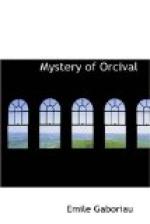“My conclusions are confirmed. The countess was carried across here.”
“Are you sure of it?” asked Plantat.
There was no mistaking the old man’s hesitation this time; he was clearly undecided, and leaned on the other’s judgment for guidance.
“There can be no error, possibly.”
The detective smiled, as he added:
“Only, as two heads are better than one, I will ask you to listen to me, and then, you will tell me what you think.”
M. Lecoq had, in searching about, picked up a little flexible stick, and while he talked, he used it to point out this and that object, like the lecturer at the panorama.
“No,” said he, “Madame de Tremorel did not fly from her murderers. Had she been struck down here, she would have fallen violently; her weight, therefore, would have made the water spirt to some distance, as well as the mud; and we should certainly have found some splashes.”
“But don’t you think that, since morning, the sun—”
“The sun would have absorbed the water; but the stain of dry mud would have remained. I have found nothing of the sort anywhere. You might object, that the water and mud would have spirted right and left; but just look at the tufts of these flags, lilies, and stems of cane—you find a light dust on every one. Do you find the least trace of a drop of water? No. There was then no splash, therefore no violent fall; therefore the countess was not killed here; therefore her body was brought here, and carefully deposited where you found it.”
M. Plantat did not seem to be quite convinced yet.
“But there are the traces of a struggle in the sand,” said he.
His companion made a gesture of protest.
“Monsieur deigns to have his joke; those marks would not deceive a school-boy.”
“It appears to me, however—”
“There can be no mistake, Monsieur Plantat. Certain it is that the sand has been disturbed and thrown about. But all these trails that lay bare the earth which was covered by the sand, were made by the same foot. Perhaps you don’t believe it. They were made, too, with the end of the foot; that you may see for yourself.”
“Yes, I perceive it.”
“Very well, then; when there has been a struggle on ground like this, there are always two distinct kinds of traces—those of the assailant and those of the victim. The assailant, throwing himself forward, necessarily supports himself on his toes, and imprints the fore part of his feet on the earth. The victim, on the contrary, falling back, and trying to avoid the assault, props himself on his heels, and therefore buries the heels in the soil. If the adversaries are equally strong, the number of imprints of the toes and the heels will be nearly equal, according to the chances of the struggle. But what do we find here?”
M. Plantat interrupted:
“Enough; the most incredulous would now be convinced.” After thinking a moment, he added:




